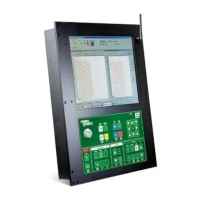iCNC Performance
2-4 SPECIFICATION Manual 0-5401
2.5 Grounding and Cable Routing
Remote Arc
Starter (RAS-1000)
Power Supply
iCNC
Star Ground on Cutting Table
Note: The gas control
module can be mounted
on top of the power
supply. If it is, it should
be grounded directly to
the power supply with
#4 AWG ground, (F).
Any location requires
grounding the power
supply to the ‘Star’
ground with the 1/0
Ground Cable (F1).
Gas Control Module
Primary location
Art # A-11875.AC
‘Star’
Ground
0 - 10 ft (0 - 3 m) Ideal
20 ft (6 m) Maximum
1/0
Ground Cable
Earth Ground
Rod
Customer supplied
A good ground will be
less than 3 ohm. Ideal 1.
1/0
Ground Cable
(F1)
Cutting Machine / Gantry
Cutting Table
Torch
#4 AWG
Ground
(F)
#4 AWG
Ground
Lifter
1/0 Ground Cable
3/0 Work Cable
#4 AWG
Ground
!
WARNING
Most common issues comes from poor or improper grounding.
- Use a single star ground point where all grounds are connected.
- Do not coil any ground wires.
- Keep ground cables as short as possible.
Good practice is to separate sensitive signal cables (encoder, arc voltage etc.) from HF sources. Never coil any excess cables
and use care when routing them.
2.5.1 Low Cost Ground Rod Tester
1. A key component of reduced EMI is a good low resistance earth ground rod. There are several very expensive instru-
ments to measure the ground but cost from several hundred to a few thousand dollars. Below is a low cost alternative
which can be constructed by qualified personnel familiar with established electrical construction and safety practices.
Previously suggested method using an incandescent light bulb will not work with GFCI outlets which are increasingly
being used and the bulbs are becoming obsolete.
2. This method, as well as the light bulb method and some of the expensive instruments, assumes the utility ground is
perfect, Zero ohms. It connects the rod being tested in series with the utility ground and measures the resistance of
both in series. If the utility ground is not zero ohms, no matter how good your rod is, you won’t get a low reading
due the higher resistance of the utility ground. Fortunately this is rare. Also if your rod is right next to another earth
grounded structure you may get a false lower reading of only resistance between that structure and your rod rather
than to gnd.
NOTE!
In the United States most standard AC outlets are 120 VAC 60 Hz. Elsewhere most outlets are 220
VAC 50Hz.
3. Obtain a transformer rated for at least 25 VA with primary voltage and frequency matching your standard outlets. The
transformer should have an isolated secondary of either 220 VAC (220 -240 is OK) or 120 VAC (110-120 is OK) and
be rated for at least 100 ma. The transformer could also have dual 115VAC primaries wired in series for 220V or in
parallel for 120 VAC. An example is Triad N-68X, shown below, rated 50VA, 50/60 Hz.
Obtain a power resistor of either 1200 (1.2K) ohms, 15-25W min, if using a 120V secondary or 2200 (2.2K) ohms, 25
-30W for a 220V secondary.

